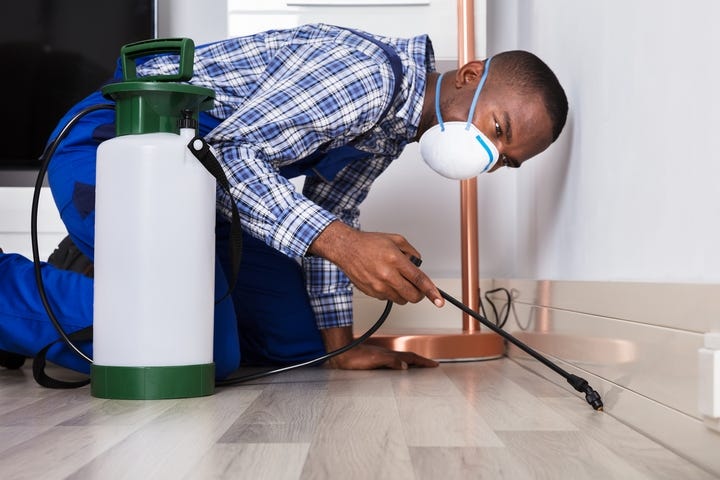Comprehensive Pest Control Services: Keep Your Residential Or Commercial Property Pest-Free!
Wiki Article
Specialist Pest Control Techniques for Long-Term Results
In the realm of pest control, attaining sustained efficiency and lasting outcomes needs a careful approach that transcends simple extermination. Specialist parasite control techniques encapsulate a thorough technique that starts with a detailed evaluation and assessment, adhered to by specific bug identification to comprehend their actions patterns. The application of Integrated Bug Management (IPM) principles, paired with eco-conscious treatments, develops the cornerstone of lasting parasite obliteration. The true test lies in the ongoing tracking and maintenance of the dealt with locations, ensuring a pest-free setting for the direct future. By delving into the complexities of these strategies, a deeper understanding of specialist pest control methods for enduring end results emerges.Inspection and Evaluation
Upon entering a residential property for insect control solutions, the first action is a complete evaluation and analysis to determine the extent of the invasion and determine the most reliable therapy strategy. Professional insect control technicians are educated to diligently examine the premises, looking for indicators of insect activity such as droppings, nibble marks, nests, or any type of structural damage. They will also evaluate the conditions that may be attracting insects, such as food sources, water leaks, or entry factors.
Bug Identification and Behavior

Additionally, understanding the habits of the identified insect is essential to applying reliable control actions. Knowing where bugs nest, what they feed on, and their activity patterns can help pest control specialists devise approaches to eliminate them successfully.
Integrated Bug Management (IPM)
Integrated Bug Administration (IPM) methods incorporate multiple methods to control and stop parasite problems in a lasting and eco-friendly manner. bed bug dog. By incorporating approaches such as organic control, habitat control, alteration of social methods, and making use of immune selections, IPM intends to lessen making use of chemical pesticidesOne of the key concepts of IPM is the focus on prevention. This positive technique involves tracking pest populations regularly to discover any type of prospective concerns before they rise. By determining pest problems at an early stage, pest control steps can be implemented swiftly and successfully.
In addition, IPM promotes making use of safe insect control approaches whenever feasible. This can include using natural killers of the parasites, presenting helpful insects, or making use of scents to interfere with breeding patterns. By minimizing dependence on chemical pesticides, IPM not only protects the environment yet likewise assists keep an equilibrium in the ecosystem.
Environmentally-Friendly Treatments
Implementing eco-conscious approaches in pest control procedures can properly address invasions while prioritizing ecological sustainability. Environmentally-friendly treatments concentrate on lessening the influence of parasite control techniques on environments, non-target organisms, and human health and wellness. These techniques frequently entail using natural predators, such as ladybugs or nematodes, to regulate pest populations, minimizing the requirement for chemical interventions. Furthermore, strategies like environment manipulation, such as changing moisture degrees or eliminating food resources, can help deter pests without using damaging materials.One more trick aspect of environmentally-friendly treatments is making use of natural and naturally degradable items that break down swiftly without leaving harmful residues in the setting. Botanical pesticides originated from plants like chrysanthemums or neem provide reliable insect control while positioning very little threat to non-target species. In addition, utilizing techniques like warmth therapies or scent catches can target particular bugs with accuracy, lowering the overall ecological impact of insect control techniques.
Continuous Tracking and Upkeep
Continual surveillance and upkeep are important elements of efficient insect control administration. Continuous tracking plays a vital function in making sure that bug invasions are found early and handled quickly. Routine evaluations by trained professionals are essential to recognize any type of structural pest control indications of pest activity, analyze the performance of previous therapies, and make modifications to the pest control strategy as required. By keeping track of pest populaces with time, parasite control professionals can track trends, prepare for prospective issues, and implement preventative procedures to reduce the threat of future infestations.
Along with monitoring, maintenance methods are essential for lasting pest control success. This includes executing appropriate cleanliness try this out actions to eliminate potential food and water sources for insects, sealing entrance indicate stop parasites from getting in the properties, and addressing any structural issues that might promote insect infestations (Exterminator DC). By including recurring tracking and upkeep into an integrated insect management strategy, businesses can ensure a pest-free environment and safeguard their property against expensive damage and health and wellness dangers
Final Thought
In conclusion, making use of professional pest control methods such as comprehensive inspection and analysis, precise parasite identification and understanding of their actions, integrated pest monitoring approaches, environmentally-friendly treatments, and ongoing surveillance and upkeep you could try here are vital for achieving lasting outcomes in insect control. By implementing these approaches, individuals can properly handle pest problems and keep a pest-free atmosphere in a sustainable way.Report this wiki page